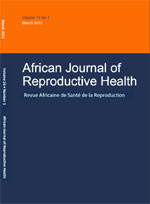
|
African Journal of Reproductive Health
Women's Health and Action Research Centre
ISSN: 1118-4841
Vol. 16, No. 1, 2012, pp. 125-132
|
 Bioline Code: rh12014
Bioline Code: rh12014
Full paper language: English
Document type: Research Article
Document available free of charge
|
|
|
African Journal of Reproductive Health, Vol. 16, No. 1, 2012, pp. 125-132
| en |
Knowledge and Utilization of the Partograph among Midwives in the Niger Delta Region of Nigeria
Opiah, Margaret M; Ofi, Abosede Bola; Essien, Ekere James & Monjok, Emmanuel
Abstract
This cross-sectional study assessed knowledge and utilization of the partograph among midwives in two tertiary health facilities in the Niger Delta Region of Nigeria. A descriptive survey design was utilized, using a structured questionnaire administered to 165 midwives purposively selected from the Federal Medical Center (FMC) (79) and Niger Delta University Teaching Hospital (NDUTH) (86). Results revealed that 84% of midwives knew what the partograph was and 92.7% indicated that the use of the partograph reduces maternal and child mortality. About 50.6% midwives in FMC and 98.8% in NDUTH indicated that it was routinely utilized in their centers. Assessment of utilized partograph charts revealed that only 18_ (37.5%) out of 48 in FMC and 17_ (32.6%) out of 52 in NDUTH were properly filled. Factors in the utilization of the partograph were:-non-availability of the partograph (30.3%), shortage of staff (19.4%), little or no knowledge in the use of the partograph (22.2%), and 8.6 percent indicated it was time consuming. A significant relationship existed between knowledge of the partograph and its utilization (χ2 = 32.298. Df = 1; P <0.05) and between midwives years of experience and its utilization (χ2=4.818, Df = 4; P <0.05). However, this study also showed that despite midwives good knowledge of the partograph, there was poor utilization in labor monitoring in both centers. Training of midwives on the use of the partograph with periodic workshops and seminars and a mandatory hospital policy are recommended and vital to the safety of women in labor in the Niger Delta region of Nigeria (Afr J Reprod Health 2012; 16[1]:125-132).
Keywords
Knowledge, utilization, partograph, midwives, labor monitoring, Niger Delta, Nigeria
|
| |
| fr |
Connaissance et utilisation de la partographie chez les sages-femmes dans la région de Niger Delta du Nigéria
Opiah, Margaret M; Ofi, Abosede Bola; Essien, Ekere James & Monjok, Emmanuel
Résumé
Cette étude transversale a évalué la connaissance et l’utilisation de la partographie chez les sages-femmes dans deux établissements de santé tertiaires dans la région de Niger Delta du Nigéria. Nous nous sommes servis du modèle de l’enquête descriptive à l’aide d’un questionnaire administré auprès de 165 sages-femmes délibérément sélectionnées à Federal Medical Centre (FMC) et au Centre Hospitalier Universitaire de l’Université de Niger Delta (NDUTH) (86). Les résultats ont révélé que 84% des sages-femmes connaissent la pantographie et 92,7% ont déclaré que l’utilisation de la partographie réduit la mortalité maternelle et infantile. Environ 50,6% sages-femmes dans le FMC et 98,8% dans NDUTH ont dit qu’elle est utilisé de routine dans leurs centres. L’évaluation des chartes de la partographie ont révélé que seulement 18 (37,5%) sur 48 dans le FMC et 17 (32,6%) sur 52 dans la NDUTH étaient bien remplies. Les facteurs dans l’utilisation de la partographie étaient la non-disponibilité de la partographie (30,3%), le maque de personnel (19,4%) peu ou pas de connaissance du tout à l’égard de l’utilisation de la partographie (22,2%) et 8,6 pourcent ont déclaré que cela prend beaucoup de temps. Il existait un rapport significatif entre la connaissance et son utilisation (χ2 =32, 298. Df =1 ; P <0,05) et entre les années d’expérience des sages-femmes et ses utilisations (χ2 = 4,818, Df = 4 ; < 0,05). Néanmoins, cette étude a également montré que malgré la bonne connaissance qu’ont les sages-femmes de la partographie, il y avait une faible surveillance du travail dans les deux Centres. Nous recommandons que les sages-femmes apprennent à utiliser la partographie à travers des ateliers périodiques et des séminaires et à travers une politique hospitalière obligatoire, ce que nous considérons comme étant essentiel pour la sécurité des femmes pendant le travail dans la région du Niger Delta du Nigéria (Afr J Reprod Health 2012; 16[1]:125-132).
|
| |
© Copyright 2012 - Women's Health and Action Research Centre
Alternative site location: http://www.ajrh.info
|
|
